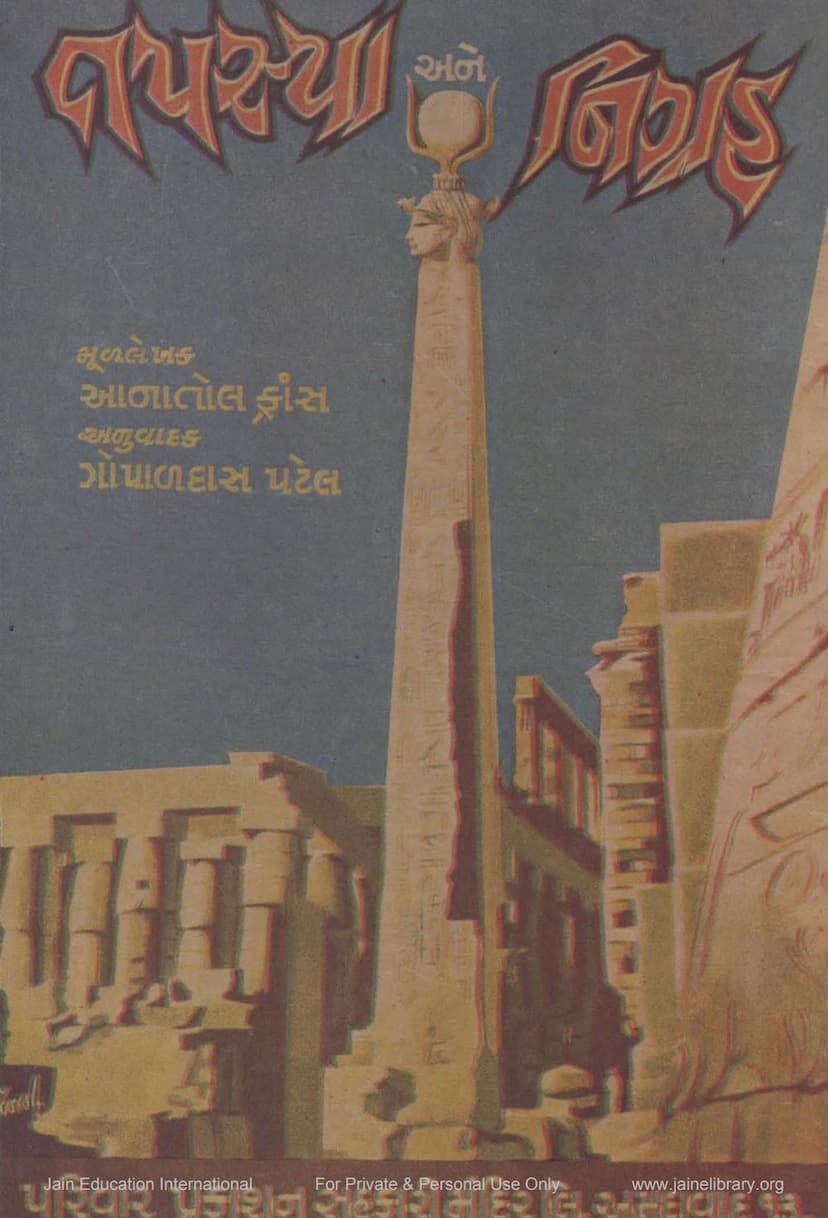Tapasya Ane Nigraha
Added to library: September 2, 2025

Summary
Here's a comprehensive summary of the Jain text "Tapasya ane Nigraha" by Gopaldas Jivabhai Patel, based on the provided pages:
Book Title: Tapasya ane Nigraha (Asceticism and Restraint) Author: Gopaldas Jivabhai Patel (Editor/Translator) Original Author: Anatole France (1844-1924), Nobel Prize-winning French author. Publisher: Parivar Prakashan Sahakari Mandir, Ahmedabad Publication Date: September 1966 Original Work: Anatole France's novel "Thaïs"
Overview:
"Tapasya ane Nigraha" is the Gujarati translation and adaptation of Anatole France's famous novel "Thaïs." The book explores the complexities of asceticism, self-control, and the enduring nature of desires, even when suppressed. It delves into the struggle between spiritual aspirations and worldly temptations, highlighting the subtle ways desires can persist and manifest.
Core Theme and Inspiration:
The central theme of the book is inspired by a famous verse from the Bhagavad Gita (Chapter 2, Verse 59):
"विषया विनिवर्तन्ते निराहारस्य देहिनः । रसवर्जं रसोऽप्यस्य परं दृष्ट्वा निवर्तते ॥" (Vishyā vinivartante nirāhārasya dehinah | Rasavarjam rasopyasya param drishtvā nivartate ||)
This verse suggests that while abstaining from sense objects can temporarily withdraw the senses, the desire (rasa) for those objects remains. True detachment and the cessation of desire can only be achieved by experiencing the "para-rasa" – the divine nectar or the supreme reality. Anatole France, through his novel, illustrates the first half of this verse, showing how outward asceticism alone does not conquer inner desires.
Plot Summary and Key Characters:
The story revolves around two main characters:
- Paphnutius: A devout and zealous ascetic who believes he has conquered all worldly desires through extreme austerities. He lives in the Egyptian desert near the Nile, practicing severe fasting, self-flagellation, and prolonged prayer. He is proud of his spiritual achievements and looks down upon others.
- Thaïs: A famously beautiful and captivating courtesan from Alexandria, known for her alluring dances and her ability to incite intense passion in her audience. She lives a life of luxury and pleasure.
Narrative Arc:
-
Paphnutius's Mission: Paphnutius, driven by his rigid interpretation of faith and a desire to "save" souls, decides to find and reform Thaïs. He believes that by forcibly removing her from her sinful life, he is fulfilling God's will.
-
The Encounter and Paphnutius's Downfall: Paphnutius travels to Alexandria and encounters Thaïs. Despite his initial intentions, Paphnutius becomes increasingly obsessed with Thaïs's beauty and the memory of her. His attempts at spiritual guidance are undermined by his own suppressed desires, which begin to surface. He finds himself dreaming of her and his rigid asceticism starts to crumble under the weight of his own temptations.
-
Thaïs's Transformation: Ironically, it is Thaïs, who is initially drawn to Paphnutius's spiritual aura, who undergoes a genuine transformation. Guided by a wise elder nun, Albina, Thaïs turns towards true devotion and finds spiritual solace and enlightenment. She sheds her worldly life and embraces a path of genuine faith and love for God.
-
The Test of Asceticism: The novel vividly portrays Paphnutius's internal struggle. His pride in his own asceticism is shattered as he realizes that outward denial without inner transformation is futile. His obsession with Thaïs, whom he tries to save, ultimately leads to his own spiritual downfall. He succumbs to the very desires he thought he had conquered, showing that true spiritual attainment comes from inner realization, not just external practices.
-
Contrasting Paths: The story contrasts Paphnutius's intellectual pride and eventual moral decay with Thaïs's journey from a life of pleasure to true spiritual awakening. It underscores the Bhagavad Gita's message that mere suppression of sensory experiences doesn't eradicate desire; rather, experiencing the "para-rasa" (divine love/truth) is the only way to overcome it.
Key Takeaways and Philosophical Implications:
- The Nature of Desire: The book emphasizes that desires are deeply rooted and cannot be simply eradicated through external means. True liberation comes from understanding and transcending desire through higher spiritual experiences.
- The Illusion of Asceticism: It critiques a form of asceticism that is based on pride and judgment rather than genuine inner transformation. Outward austerity without inner purity can be a breeding ground for hypocrisy and deeper spiritual pitfalls.
- The Power of Grace and Devotion: The story highlights that genuine spiritual growth and salvation often come through sincere devotion (Bhakti Yoga) and divine grace, as exemplified by Thaïs's eventual transformation.
- Cultural Context: The novel is set in ancient Alexandria and the Egyptian desert, exploring the philosophical and religious currents of that era, including paganism and early Christianity. The Gujarati translation aims to make these themes accessible and relevant to a modern Indian audience.
Editorial Notes and Contributions:
- Gopaldas Jivabhai Patel's Role: Patel's translation is praised for its clarity and ability to capture the essence of Anatole France's style in Gujarati. He successfully adapted the story to resonate with the Indian spiritual and philosophical context.
- Mahadev Desai's Influence: The publishers mention that Gandhiji's secretary, the late Mahadev Desai, was very pleased with this narrative and had a strong desire for it to be translated into Gujarati.
- Maganbhai Desai's Contribution: Manganbhai Desai's detailed and accurate editing and suggestions significantly benefited the work. He also provided a preface titled "Prem Bhakti ni Sanjeevani" (The Elixir of Loving Devotion).
- Praise for the Translation: The book was well-received, even by prominent figures like Mahadev Desai and those associated with Gandhiji's Ashram, indicating its perceived spiritual and intellectual value.
In essence, "Tapasya ane Nigraha" is a profound exploration of the human condition, contrasting outward religious observance with the inner journey of spiritual realization. It serves as a reminder that true liberation lies not in the suppression of desires, but in the transcendence of them through genuine divine love and understanding.